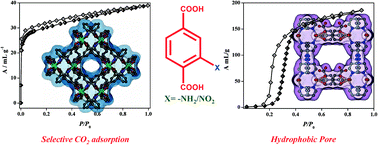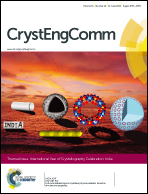Two 3D metal–organic frameworks of Cd(ii): modulation of structures and porous properties based on linker functionalities†
Abstract
Two new Cd(II) based metal–organic frameworks (MOFs), {[Cd(NH2-bdc)(bpe)]·0.5EtOH}n (1) and {[Cd(NO2-bdc)(azbpy)]·4H2O}n (2) (NH2-bdc = 2-amino terephthalic acid, bpe = 1,2-bis(4-pyridyl)ethane, NO2-bdc = 2-nitro terephthalic acid, azbpy = 4,4′-azobipyridine), have been synthesized by a solvent diffusion technique and structurally characterized. Both the frameworks are constructed based on exo-bidentate pyridyl type linkers of similar length but different functionalities. Compound 1 has a 3D structure in which the –NH2 functional group of NH2-bdc is coordinated to Cd(II) and a 1D ultra-micropore accommodates ethanol guest molecules. The desolvated framework of 1 (1′) is rigid as realized from the PXRD patterns and shows a type-I CO2 uptake profile with a reasonably high isosteric heat of adsorption value. Density functional theory (DFT) calculation shows that aromatic π electrons interact strongly with CO2 and the binding energy is 33.4 kJ mol−1. Compound 2 has a two-fold interpenetrated 3D porous framework structure where pendent –NO2 groups of NO2-bdc are aligned on the pore surface. The desolvated framework (2′) exhibits structural transformation and is nonporous to N2. Smaller and gradual CO2 uptake in 2′ can be attributed to the structural contraction. The solvent (H2O, MeOH and EtOH) vapour adsorption studies suggest that the pore surface of 2′ is hydrophobic in nature.

- This article is part of the themed collection: International Year of Crystallography Celebration: India

 Please wait while we load your content...
Please wait while we load your content...